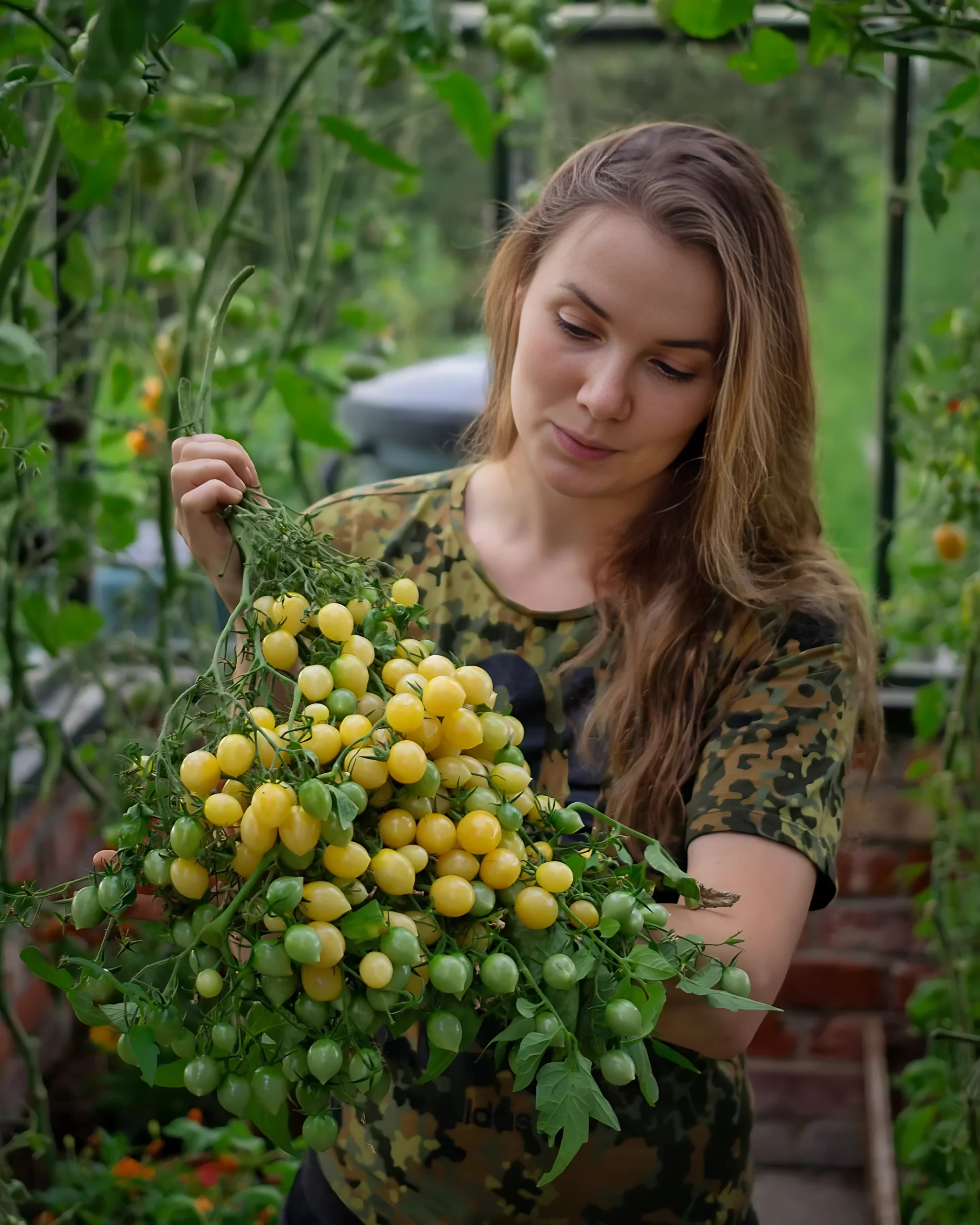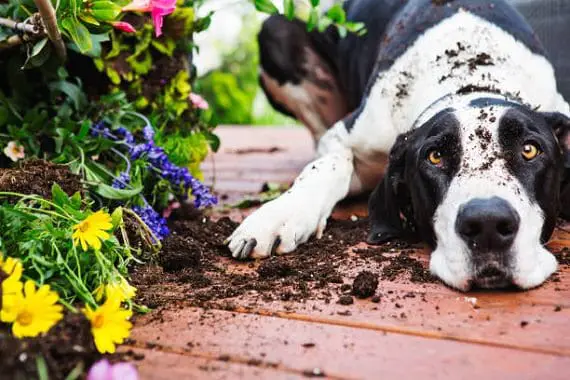Knowing about Plants Toxic to Dogs can help you save your best companion’s life. Here are the ones you must avoid to safeguard your pooches!
We all love our pets and do everything to make sure they are safe from harm’s way. Keeping that in mind, you might be surprised to know that various plants can pose a threat to your dog’s health. Here is an exclusive list of Plants Toxic to Dogs!
Poisonous Plants for Dogs
1. Yew

Yew is a species of coniferous evergreen trees that belong to Europe, the Atlas Mountains in Morocco, and Western Asia (Caucasus). In Poland, various species are cultivated as outdoor plants. The entire yew plant is highly toxic for dogs except for the red berry.
Toxins: Large amounts of toxic compounds, particularly taxine and ephedrine
Severity: Very high
Malicious parts: The whole plant
Symptoms: Vomiting, difficulty in breathing, fatal changes in heart-rate, and may cause death.
2. Lantana Camara
Lantana Camara is a small everlasting perennial shrub native to Central and South America. Some cultivars are considered a troublesome weed, growing in a wide range of warm climatic conditions. It is not safe for the pets at your home due to the presence of toxic substance pentacyclic triterpenoids. For cattle, it’s considered a fatal plant.
Toxin: Pentacyclic triterpenoids
Severity: Moderate to High
Malicious parts: The whole plant
Symptoms: Vomiting, diarrhea, labored breathing, weakness, appetite, loss, hepatic impairment.
3. Delphinium
Delphinium is a perennial flowering plant, belonging to the Ranunculaceae family. It has about 250 species in temperate regions of the northern hemisphere, except the eastern areas of Africa. However, all species of delphinium are toxic to humans and dogs.
Toxin: Diterpene alkaloids
Severity: High
Malicious parts: All parts of the plant
Symptoms: Paralysis, constipation, colic, salivation, muscle tremors, stiffness, weakness, cardiac failure, and the paralysis of respiratory death.
Note: The toxicity of the plant depends on the season and conditions in the field; as the plant matures, it generally becomes less toxic.
4. Jimson Weed (Datura stramonium)
Jimson Weed belongs to the nightshade family (Solanaceae Adans). This beautiful plant, from the Datura genus, produces trumpet-like flowers in various colors. It can be a lovely addition to your flower collection. However, jimson weed can be harmful if consumed by a dog at your home.
Toxins: Tropane alkaloids, hyoscyamine, atropine, scopolamine
Severity: Very high
Malicious parts: The whole plant
Symptoms: Drowsiness, confusion, initially tachycardia, bradycardia later, tachypnea, mydriasis, sometimes clonic convulsions, increased body temperature, and may cause death.
5. Calla palustris
Calla is a rhizomatous perennial plant species from the family Araceae. It is grown as an ornamental plant and contains calcium oxalate crystals, which are not considered safe for pets and can cause injury if ingested.
Toxins: Calcium oxalate crystals
Severity: High
Malicious parts: The whole plant, particularly sap.
Symptoms: As it comes in contact with the mucous membranes of the digestive system, it may cause severe, painful burning sensation and inflammation. If ingested in large amounts, it can cause diarrhea and paralysis. The sap of the plant can also cause severe skin irritation.
6. Veratrum album
Also known as white veratrum and European white, hellebore is a toxic plant from the Liliaceae family. People grow it as an ornamental plant as well. However, if you have a dog, then be careful, as it can be harmful to them.
Toxin: Alkaloids sterol
Severity: Very high
Malicious parts: All parts of the plant
Symptoms: Abdominal pain, hypotension, vomiting, bradycardia, and dilated pupils.
Check out our article on poisonous houseplants for dogs here!
7. Black hellebore
Christmas rose, or black hellebore is a perennial flowering plant that looks like wild roses. All parts of this plant are unsafe for dogs.
Toxin: Alkaloids
Severity: Very high
Malicious parts: All parts of the plant
Symptoms: Irritation of the gastric mucosa and respiratory tract, severe sneezing, coughing, salivation, tearing, nausea, vomiting, diarrhea. Larger intake can cause abdominal cramps and larynx, impaired coordination, and myocardial damage.
8. Hellebore green
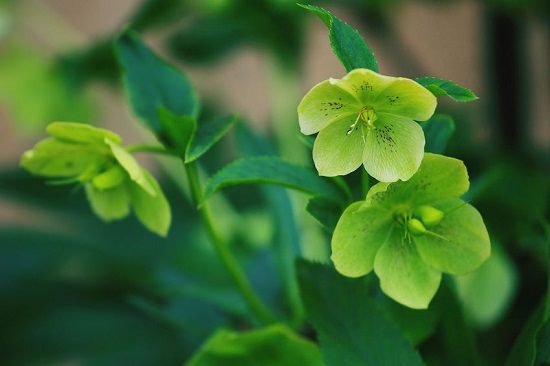
Green hellebore is also called Helleborus viridis; it prefers bright forests, spring fens, and banks of streams. It grows in the wild but can also be cultivated as an outdoor plant. The presence of toxic elements makes it dangerous for dogs.
Toxins: Glycosides and bufadienolides
Severity: Very high
Malicious parts: All parts of the plant
Symptoms: Strong irritation of the mucous membranes, impaired coordination, impaired breathing, and paralysis.
9. Nymphaea alba
Commonly known as the water lily, it is a perennial species of the family Nymphaeaceae. It is also grown as an ornamental plant.
Toxins: Rhizomes contain tannins, glycoside
Severity: Very high
Malicious parts: All parts of the plant
Symptoms: Alkaloids act on the central nervous system, paralyzing the cerebral cortex.
10. Castor Bean (Ricinus communis)
Castor bean is grown for decorative purposes, mainly because of healthy-foliage, lush growth, and fruit- a source of castor oil. The cultivation, however, is hazardous because of the highly toxic properties. Its ingestion can cause severe health issues among dogs.
Toxins: Alkaloid and protein ricin
Severity: Very high
Malicious parts: All parts of the plant, especially the seeds
Symptoms: Vomiting and diarrhea, severe congestion of the organs of the digestive system, and kidney agglutination (clumping), cell, and precipitation of fibrin in the blood. Ricin poisoning can lead to death.
Note: The seeds contain ricin, which is lethal to humans at a dose greater than 0.2 g – that is present in the seeds of the castor fruit. In the case of an animal, death may occur after eating a piece of plant or just a few grains of castor seed.
11. Yellow azalea (Rhododendron luteum)
Also known as honeysuckle azalea, it is an easy growing, decorative plant, from heath family (Ericaceae). It flowers fragrant, shiny yellow flowers that may draw the attention of your dog. Thus, be careful to keep them away from this toxic plant.
Toxin: Grayanotoxin
Severity: High
Malicious parts: All parts of the plant
Symptoms: Paralysis, gnashing teeth, rapid breathing and heart rate, and may cause death due to respiratory paralysis.
12. Lily of the Valley
Lily of the valley is a perennial flowering plant that blossoms sweet-smelling, droopy flowers in summers and late springs. If your dog has consumed any part of the plant, then it needs to be cured immediately within 1 hour of consumption, as it can be fatal.
Toxins: Saponins and cardiac glycosides
Severity: Very high
Malicious parts: All parts of the plant
Symptoms: Dilated pupil, cardiac arrhythmias, nausea, vomiting, diarrhea, headache, dizziness, death.
13. Digitalis Purpurea (Foxglove)
Commonly known as foxglove, it is short-living perennial or biennial, which is grown as an ornamental plant. The entire plant of foxglove is toxic to pets and humans.
Toxins: Saponins, cardiac glycosides, and digitoxin
Severity: Very high
Malicious parts: The whole plant
Symptoms: Vomiting, diarrhea, cardiac arrhythmias, cardiac failure, and death.
14. Yellow foxglove (Digitalis Grandiflora Mill.)
Yellow foxglove can be a beautiful addition to your garden but can be hazardous to your pets, as it contains toxic elements that can be life-threatening when ingested or consumed. If you find any of the below symptoms, then contact your vet immediately before the condition gets out of control.
Toxins: Cardenolides and digitoxin
Severity: Very high
Malicious parts: The whole plant
Symptoms: Poisoning, dizziness, blurred vision, diarrhea, vomiting, cramps coronary vessels, dyspnea, cyanosis, and death.
15. Belladonna (Atropa belladonna)
This herbaceous plant is also known as deadly nightshade or belladonna, meaning ‘beautiful lady.’ However, this attractive plant can be fatal for your dog if ingested as the plant is highly toxic.
Toxins: Atropine, hyoscyamine, and by-alkaloids
Severity: Very high
Malicious parts: All parts of the plant are highly toxic
Symptoms: Paralysis of the brain. The first signs of poisoning are severe agitation and hallucinations euphoric, seizures, photophobia, loss of consciousness, and in extreme cases, death due to respiratory arrest during a coma.
16. Henbane

Henbane or striking nightshade is a poisonous plant of the Solanaceae family. It contains several alkaloids that can harm your dogs if ingested.
Toxins: Alkaloids scopolamine, atropine and L-hyoscyamine
Severity: Very high
Malicious plants: All parts of the plant
Symptoms: Mydriasis and dryness of mucous membranes of the mouth and throat, hallucination, agitation, which is characteristic and distinguishes as the poisoning of mandrakes or Datura.
Want to know is rosemary toxic to cats? To find out, click here!
17. Snowdrop (Galanthus)
The small, drooping, bell-shaped flowers of snowdrop can be a center of attraction in any home decor. However, if you have pets like a dog or cat, then be careful as the bulb of Galanthus is highly toxic if ingested.
Toxin: Phenanthridine alkaloids, galantamine
Severity: Very high
Malicious parts: The whole plant, particularly tubers
Symptoms: Vomiting, diarrhea, loss of consciousness, rapid pulse, and breathing.
18. Laburnum ordinary
Laburnum or golden rain is an attractive ornamental plant with pendulous yellow flowers. It is one of the toxic plants for dogs.
Toxins: Alkaloids: cytisine
Severity: Very high
Malicious parts: The whole plant
Symptoms: Salivation, convulsions, breathing disorders. It also causes local irritation of the gastric mucosa, burning sensation in the mouth and throat, vomiting.
19. Aconite
Aconitum, monkshood, blue rocket, or queen of poison is a popular garden plant that resembles delphiniums. The entire plant is toxic, and the roots are highly poisonous.
Toxins: Alkaloids and aconitine
Severity: Very high
Malicious parts: The whole plant
Symptoms: Respiratory paralysis, vomiting, tremors and muscle spasms, low body temperature, bradycardia, convulsions, cardiac arrhythmias of ventricular fibrillation and including death.
20. Colchicum
Also called Meadow saffron and autumn crocus, it is commonly grown as a garden and indoor plant. The whole plant is toxic to dogs, including flowers and seeds.
Toxin: Alkaloid and colchicine
Severity: Very high
Malicious parts: The whole plant
Symptoms: Vomiting, diarrhea, alopecia, agranulocytosis, inhibition of spermatogenesis, seizures, and even death.
21. Adonis Vernalis
Adonis Vernalis is easy to grow outdoor ornamental plant, mainly grown for medicinal uses. However, the entire plant is poisonous for your pets.
Toxin: Glycosides cardenolides
Severity: High
Malicious parts: The whole plant
Symptoms: Nausea, vomiting, cramps and paralysis, blurred vision, and at high doses, death from cardiac arrest.
22. Ligustrum vulgare
Ligustrum vulgare is a fast-growing deciduous shrub, native to Northern Africa, Europe, and western Asia. It is cultivated as an ornamental plant. Its berries are poisonous to dogs if consumed in large quantities.
Toxin: Glycoside
Severity: High
Malicious part: Berries are generally considered to be the most toxic, but all parts of the plant can be poisonous.
Symptoms: Vomiting, diarrhea, dilated pupils, paralysis, rapid pulse, irritation of mucous membranes. In extreme cases, death.
23. Daphne
Daphne is grown by many gardeners as an ornamental plant. The entire plant is toxic, but it is the berries that are extremely poisonous. Thus, keep your dogs away from the plant.
Toxins: Calcium oxalate and glycosides
Severity: Very high
Malicious parts: Entire plant
Symptoms: Swelling of the mouth, salivation, difficulty in swallowing, cramps, vomiting, and bloody diarrhea. The plant is also harmful to the skin and mucous membranes; it may cause redness, swelling, and blistering of the skin, and even death in some cases.
24. Liverwort

Liverwort is a species of perennial plant of the Ranunculaceae family. Its different varieties are grown as ornamental plants. The whole plant is toxic to dogs, thus, harmful if consumed.
Toxins: Saponins glycosides and flavonoids (kaempferol and quercetin)
Severity: High
Malicious parts: The entire plant
Symptoms: Skin irritation, burns after swallowing: inflammation of the lining of the mouth, stomach and intestines, bloody diarrhea, fainting, and sometimes convulsions, swelling of the kidneys with hematuria and proteinuria, irreversible kidney damage.
25. Tobacco (Nicotiana)
If you have grown nicotiana as an ornamental plant, then there will be chances that your puppies may get attracted to the fragrant flowers, which can be fatal if ingested or consumed.
Toxin: Nicotine
Severity: Very high
Malicious parts: All parts of the plant
Symptoms: It may permanently block the nervous system, as it binds to the nerve cells, impairing the metabolism, causing photophobia, vomiting, and diarrhea. In larger doses, followed by loss of consciousness, convulsions, and death.
26. Eupatorium
Eupatorium is a species of flowering plants in the Asteraceae family. There are around 40-60 species of plants found mainly in America. However, several species exist in Asia and Europe; most of them are herbaceous perennials.
Toxin: Carcinogenic alkaloids pyrrolizidine
Severity: Very high
Malicious parts: The whole plant
Symptoms: Vomiting, liver damage, muscle tremors, weakness, constipation, and death.
27. Common Euonymus (Euonymus europaeus L.)
Euonymus grows in shiny evergreen leaves and a bunch of green flowers along with orange fruits. It includes various ground covers and landscape ornamental shrubs.
Toxin: Glycosides
Severity: Very high
Malicious parts: The entire plant, but primarily the fruit
Symptoms: Vomiting, diarrhea, tremors, convulsions, cardiac disorders, paralysis, and, eventually, death.
28. Daphne Cneorum (Daphne cneorum L.)
Native to the central and southern Europe, Daphne cneorum is also known as rose daphne or garland flower. It grows in a bunch of attractive dark pink flowers that contain calcium oxalate, which is not safe for your dog.
Toxins: Calcium oxalate and glycosides
Severity: High
Malicious parts: The whole plant
Symptoms: Irritation of the mucous membranes, gastrointestinal tract, and death.
29. Anemone
Anemone comes in different varieties, flowering from late springs (May-June). All types of anemones are toxic to dogs due to the poisonous substance-Anemonin.
Toxins: Anemonin
Severity: High
Malicious parts: The whole plant
Symptoms: It can irritate the skin and also cause inflammation to the lining of the mouth, stomach, and intestines, bloody diarrhea, fainting, and sometimes convulsions, respiratory, and swelling of the kidneys with hematuria and proteinuria, and irreversible kidney damage.
30. Scotch Broom (Cytisus scoparius)
Scotch broom shrub comes in a category of toxic plants for dogs. Hence keep your pets away from this attractive plant.
Toxins: Quinolizidine alkaloids, tyramine, and dopamine
Severity: High
Malicious parts: The whole plant
Symptoms: Reduces sensitivity and nerve conduction in the myocardium.
31. Tansy
Tansy is a herbaceous perennial flowering plant with yellow, button-like flowers. It is a low-maintenance plant that also acts as a natural repellent against deadly insects. The plant also contains oil, which is considered toxic for dogs.
Toxins: Flowers contain oil from 1 to 1.5% whose main ingredients are thujone, camphor, borneol, and bitter lactone, flavonoids: luteolin
Severity: High
Malicious parts: The whole plant
Symptoms: Vomiting, diarrhea, abnormal heart rhythm, damage to the liver, and kidneys.
32. Japanese Pieris (Pieris japonica)
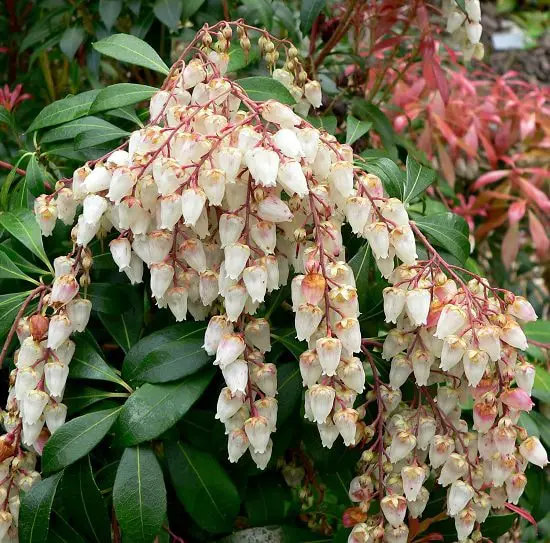
Pieris japonica or ‘Red Head’ is an evergreen shrub that reaches up to 6-8 feet long. It grows decorative, bell-shaped flowers with attractive glossy leaves. The plant can be poisonous if ingested by pets or humans.
Toxin: Grayanotoxin ‘mad honey.’
Severity: Very high
Malicious parts: The whole plant
Symptoms: Vomiting, diarrhea, depression, cardiovascular collapse, salivation, weakness, lethargy, low blood pressure, cardiovascular failure, and death.
33. Sweet pea (Lathyrus odoratus)
Sweet pea is a fast-growing, annual climbing plant that can survive in a different range of environments. The entire plant is considered toxic for dogs because of the poisonous substance-beta aminopropionitrile.
Toxin: Beta-aminopropionitrile
Severity: High
Malicious parts: The whole plant, especially the seeds
Symptoms: Weakness, lethargy, convulsions, tremors, shortness of breath, increased intracranial pressure, stiffness of the limbs, death.
34. Dog Hobble (Leucothoe Fontanesiana)
Also known as a dog laurel and fetter bush, it is an evergreen shrub with white, fragrant and droopy, bell-shaped flowers. Dog hobble thrives well in any environment with little care. Unluckily, this beautiful flower is toxic to dogs.
Toxin: Grayanotoxins
Severity: High
Malicious parts: Flowers and leaves
Symptoms: Weakness, diarrhea, paralysis, cardiovascular collapse, and death.
35. Scopolia carniolica
Scopolia carniolica is a creeping perennial plant with yellow to dull red flowers. The whole plant is toxic for dogs, so if you are growing it, be careful.
Toxins: Tropane alkaloids scopolamine and atropine
Severity: Very high
Malicious parts: The whole plant
Symptoms: Acceleration of heart rate, dilated pupils, restlessness, hallucinations, at higher doses rages, and death due to respiratory paralysis.
36. Drimia Maritima (Urginea maritima)
Drimia Maritima is also known as sea onion, red squill, squill, and sea squill. It closely resembles onions though sea onions are not edible since they contain toxic elements like Cardiac glycosides and bufadienolides.
Toxins: Cardiac glycosides and bufadienolides
Severity: High
Malicious parts: The entire plant, particularly onions and juice
Symptoms: Vomiting, diarrhea, heart disorders, irritation of the lining of the digestive tract, and stimulation of the vagus nerve. It can cause skin rash and blisters.
Edible Plants Poisonous for Dogs
37. Crabapple (Malus Mill.)
Crab apples are quite delicious and healthy. Though dogs can eat crab apple but with caution because all parts of this fruit are not good for your puppy.
Toxins: Leaves contain cyanogenic glycosides that turn in to cyanide after consumption. The seeds also contain compounds that can be converted into cyanide, such as amygdalin. These compounds turn into hydrogen cyanide when the seeds are chewed and release degrading enzymes. These enzymes include amygdalin beta-glucosidase, prunasin beta-glucosidase.
Severity: Very high
Malicious parts: Seeds, withered stalks, and leaves
Symptoms: Restlessness, difficulty breathing, collapse, the brick red color of the mucous membranes, dilated pupils, sudden death.
38. Peach (Persica Mill.)
Peaches are loaded with nutrients and antioxidants that are good for humans and animals both. So, if you are confused about whether you can share this tasty treat with your dog, then the answer is- Yes, but feed your puppy with some cut-up pieces of the flesh, as that’s safe for your dog’s health. Excessive consumption of the fruit may cause temporary diarrhea. Also, seeds, stems, and leaves are toxic to dogs that can be harmful if ingested.
Toxins: Cyanogenic glycosides, amygdalin beta-glucosidase, prunasin beta-glucosidase, mandelonitrile lyase
Severity: Very high
Malicious parts: Seeds, stems, wilted leaves
Symptoms: Restlessness, difficulty breathing, collapse, the brick red color of the mucous membranes, dilated pupils, sudden death.
39. Plum (Prunus domestica L.)
Plums are safe for dogs, but due to high sugar content, they are not a good treat for them. Also, try to keep away the plum pits from your dogs because the seeds contain cyanide, which is quite harmful and can be fatal if ingested.
Toxin: Cyanogenic glycosides
Severity: Very high
Malicious parts: Seeds, withered stalks, and leaves
Symptoms: Restlessness, difficulty breathing, collapse, the brick red color of the mucous membranes, dilated pupils, sudden death.
40. Common apricot (Prunus armeniaca)
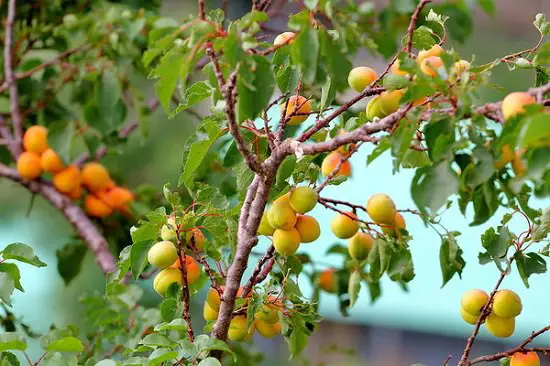
Apricots are not dangerous for your dogs but keep them away from eating apricot seeds and other parts of the plant since they contain a trace amount of cyanide, which can be harmful if consumed in large quantities.
Toxin: Cyanogenic glycosides that into cyanide after consumption
Severity: Very high
Malicious parts: Seeds, withered stalks, and leaves
Symptoms: Restlessness, difficulty breathing, collapse, the brick red color of the mucous membranes, dilated pupils, sudden death.
41. Black cherry (Prunus serotina)
Cherries are packed with essential vitamins and antioxidants, which are good for dogs as well. But, eating too many cherries may also cause diarrhea. The pit stems and leaves are the most harmful parts and can be very dangerous if consumed in large quantities.
Toxins: Leaves, especially when they wilted contain cyanogenic glycosides that turn up after eating cyanide
Severity: Very high
Malicious parts: Seeds and dead leaves
Symptoms: Vomiting, diarrhea, convulsions, anxiety, fear, salivation, reddening of the skin, and in severe cases, seizures, and death.
42. Common bird cherry (Padus avium Mill.)
Also known as hackberry, hagberry, and mayday tree, it is a species of cherry. The edible fruits are bitter, although it contains pectin, minerals, and vitamin C. The leaves and seeds contain poison hydrogen cyanide; hence, stay careful if you are a dog parent.
Toxins: Glycosides, prulaurasin, and amygdalin. Volatile compounds emitted by flowers contain a lot of bactericidal phytoncides. The bark and leaf buds contain cyanogenic glycosides
Severity: Very high
Malicious parts: The whole plant, including the fruit
Symptoms: Vomiting, diarrhea, convulsions, anxiety, fear, salivation, reddening of the skin, and in severe cases, seizures, and death.
43. Wild Cherry (Prunus avium)
Though fruits are edible both raw and cooked form for your dogs, but only in small quantity. Also, keep your dog away from leaves, seeds, and twigs as they are highly toxic and contain cyanogenic glycosides.
Toxins: Cyanogenic glycosides
Severity: High
Malicious parts: Seeds
Symptoms: Restlessness, difficulty breathing, collapse, the brick red color of the mucous membranes, dilated pupils, sudden death.
44. Sour Cherry (Prunus Cerasus)
Sour cherry is also known as a tart cherry; it is quite similar in many features with a sweet cherry. If you have a pet dog, then make sure your puppy is not consuming the pits, stems, and leaves of the plant. Since it contains toxic elements that can be fatal.
Toxins: Cyanogenic glycosides that turn up cyanide. The seeds contain compounds that can be converted into cyanide, such as amygdalin. These compounds turn into hydrogen cyanide when the seeds are chewed and release degrading enzymes. These enzymes include amygdalin beta-glucosidase, prunasin beta-glucosidase lyase mandelonitrile.
Severity: Very high
Malicious parts: Seeds, stems wilted leaves
Symptoms: Restlessness, difficulty breathing, collapse, the brick red color of the mucous membranes, dilated pupils, sudden death.
45. Elderberry (Sambucus nigra L.)
Raw elderberries are toxic, as they contain alkaloid cyanogenic glycosides. This plant produces cyanide if consumed and can cause death if left untreated within less than an hour after consumption.
Toxins: Cyanogenic glycosides, amygdalin
Severity: High
Malicious parts: A whole plant, particularly raw fruit
Symptoms: Weakness, nausea, vomiting, diarrhea, rapid pulse, and breathing disorders, including shortness of breath.
46. Potato (Solanum tuberosum L.)
Raw potato contains solanine, which is poisonous to some dogs. So, if you want to feed your dog a potato, then boil or bake it before serving without adding anything into it.
Toxin: Solanine
Severity: Very high
Malicious parts: All parts of the plant, mainly stalks, leaves, flowers, green and sprouting bulbs
Symptoms: Solanine is poorly absorbed from the gastrointestinal tract and has carcinogenic properties. Vomiting, diarrhea, hematuria, urinary tract spasms, loss of sensation, reduced body temperature, acute inflammation of the lining of the stomach and intestines, intestinal vascular edema, lethargy, salivation, miosis, proteinuria, and seizures. It should be noted that high doses of solanine can lead to coma and death.
47. Rhubarb
If you have grown rhubarbs in your backyard and you are a dog parent, then be careful that your puppy is not munching on its leaves since they contain oxalic acid, which is a poisonous substance and may cause health-related problems if left untreated.
Toxins: Anthraquinones glycosides such as Emodin and rhein, senna glycosides, oxalic acid.
Severity: High
Malicious parts: All parts of the plant
Symptoms: Vomiting, diarrhea, can create kidney stones, reduced absorption of zinc, calcium, magnesium.
48. Hops
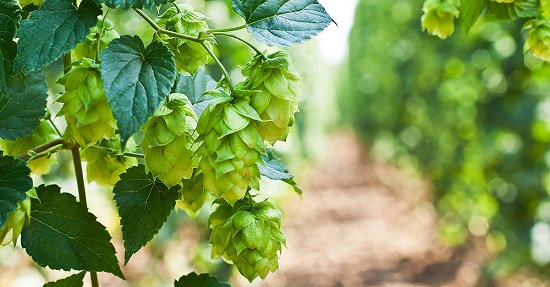
Hops have a bitter flavor, which is used as a calming agent in herbal tea and supplements. Also, dried hops are used as a stabilizer and flavoring agent both commercially and at home. However, hops plant is not considered good for dogs as it has been categorized as an extremely poisonous plant and can cause death if ingested even in small quantities.
Toxins: Essential oil, tannins, flavonoids
Severity: Very high
Malicious parts: The whole plant
Symptoms: Heavy panting, high body temperature, convulsions, and death.
49. Opium poppy (Papaver somniferum L.)
Poppy seeds are not good for dogs as they contain alkaloids that can have bad effects on the central nervous system of your dog and can cause opioid poisoning; hence, it will be better to keep your puppy distant from poppy!
Toxins: Various alkaloids including morphine, codeine, papaverine, narcotine
Severity: Very high
Malicious parts: A whole plant, particularly the juice and the seeds of immature and mature plants.
Symptoms: Drowsiness, nausea, dizziness, allergic reactions, loss of appetite, hallucinations, including death.
50. Grapevines (Vitis vinifera)
Grapevines are toxic for dogs, even if they consumed in smaller quantities; consumption of raisin (dried grapes) and grapes can lead to sudden kidney failure with anuria (lack of urine production). However, kidney damage is not seen in all dogs. Also, the reason behind the toxicity is yet unknown.
Toxins: Unknown
Severity: Very high
Malicious parts: The whole plant, especially fresh and dried fruits (raisins), leaves
Symptoms: Vomiting, diarrhea, weakness, increased drinking, abdominal pain, oliguria, anuria, kidney damage, and death.
51. White mustard (Sinapis alba) & Black mustard (Brassica nigra)
Whether it is white mustard or black, both of them are toxic to dogs. Mustard seeds contain poisonous compounds that can cause inflammation of the stomach or intestinal tract. However, if your dog has ingested mustard seeds in a large amount, then contact your vet without wasting time as it is one of the plants toxic to dogs.
Toxins: Essential oils and poisonous glycosides
Severity: Very high
Malicious parts: The whole plant and seeds.
Symptoms: The seeds of this plant, when ingested in large quantities, irritate the digestive and respiratory system. Seeds ingested in large doses, can damage the kidneys and cause urinary tract hematuria and proteinuria and may cause damage to the central nervous system and in a few cases can lead to death.
Wild Toxic Plants for Dogs
52. Poppy
If your house is situated near a poppy field and you also own a dog, then be sure to keep your pooch away from poppy fields as the entire plant is considered toxic for dogs and can cause opioid poisoning.
Toxins: The entire plant contains a milky white juice (from which opium-produces), which includes slightly poisonous alkaloids and small amounts of papaverine. Flakes also contain anthocyanin, alkaloids morphine, and codeine.
Severity: Very high
Malicious parts: The whole plant, juice, seeds
Symptoms: Drowsiness, nausea, dizziness, allergic reactions, loss of appetite, hallucinations.
53. Hemlock (Conium maculatum L.)
The toxins in hemlock or poison hemlock are dangerous to many animals and humans. If your dog has ingested even a small amount of these herbs, then it is necessary to contact your veterinarian immediately.
Toxin: Pyridine alkaloids
Severity: Very high
Malicious parts: The whole plant, especially stem and rhizome
Symptoms: Increased temperature, tremors, convulsions, panting, frothing, coma, and death.
54. Water hemlock (Cicuta virosa L.)
Water hemlock is toxic in a similar way as poison hemlock; the toxins in both plants are deadly for humans and animals. If your pets ingest any hemlock, contact your vet without wasting time.
Toxin: Cicutoxin
Severity: Very high
Malicious parts: The whole plant, especially stem and rhizome
Symptoms: Salivation, nausea, vomiting, dilated pupils, seizures, loss of consciousness, difficulty in breathing. Death may occur due to paralysis of the respiratory center.
55. Euonymus (Euonymus verrucosus Scop.)
Euonymus is grown as ornamental plants for their bright orange foliage and yellow-green flowers, turning into pink berry-like fruit that might attract your dog, which is not considered to be safe. Since this plant contains alkaloids that can be fatal for your pooch if ingested.
Toxin: Alkaloids
Severity: Very high
Malicious parts: The whole plant, mainly fruit
Symptoms: Vomiting, diarrhea, tremors, convulsions, cardiac disorders, paralysis, and death.
56. Mugwort (Artemisia vulgaris L.)
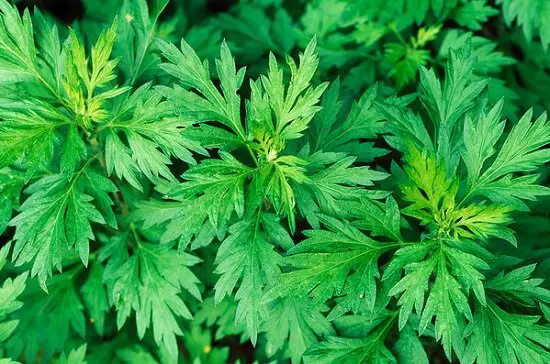
Though mugwort has been used for medicinal purposes and as a culinary herb, despite that, it is not good for your dogs as the plant contains a terpene, which can be harmful to your dog if ingested.
Toxin: Organic chemical compound-terpene
Severity: High
Malicious parts: The whole plant
Symptoms: Vomiting, diarrhea, irritation of the nervous system.
57. Black honeysuckle (Lonicera nigra L.)
Black honeysuckle can be a gorgeous addition to your garden, as it spreads rapidly in attractive fragrant flowers, but be careful if you have a playful dog. Since chewing or biting the berries of honeysuckle plants in large quantities can be harmful.
Toxins: Saponins and small amounts of cyanogenic glycosides
Severity: Very high
Malicious parts: The whole plant
Symptoms: Kidney damage, dizziness, cyanosis, tachycardia, respiratory paralysis, nausea, vomiting, agitation, abnormal heart rhythm, bloody diarrhea, convulsions, dilated pupils, coma.
In addition to the content of poisonous and harmful plants, dogs may also get hurt by thorns and spikes of some plants discussed below:
- Rose
- Most cacti
- Raspberry (Rubus idaeus L.)
- Plants of blackberry (Rubus L.)
- Plants of holly (Ilex L.)
- Ononis spinosa (Ononis spinosa L.)
- Sea buckthorn (Hippophaë rhamnoides L.)
- Pyracantha coccinea (Pyracantha coccinea M.Roem)
- Caragana arborescens (Caragana arborescens Lam)
- Hawthorn (Crataegus L.)
- Thistle (Carduus L.)
- Genus thistle (Cirsium Mill.)
- Barberry (Berberis L.)
- Mat-grass (Nardus stricta L.)
- Reed (Calamagrostis Adans.) Chaenomeles (Chaenomeles Lindl)
- Chestnut (Aesculus L.) – spikes on casings fruits;
- Blackthorn (Prunus spinosa L.)
- Black locust (Robinia pseudoacacia L.)
- Yucca (Yucca L.)
- Dracaena (Dracaena L.)
- Agave
- Crown of Thorns
- Bougainvillea
In any case, if you notice that the dog is poisoned from eating dangerous plants or encountered any allergic reactions due to contact with the plant, then contact your vet immediately without wasting any time.

